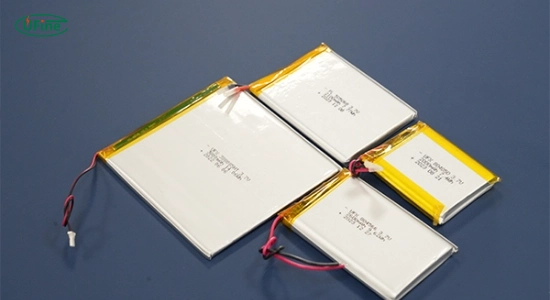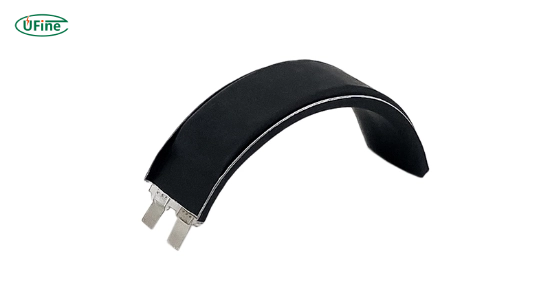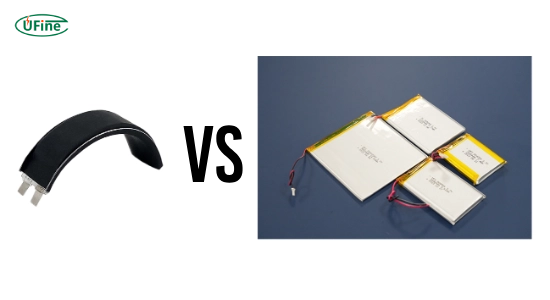
- Part 1. Understanding flat lithium battery technology for wearables
- Part 2. How curved lithium batteries are designed for ergonomic wearable devices
- Part 3. Comparing battery life: flat vs curved lithium battery performance
- Part 4. The role of battery shape in wearable comfort and design
- Part 5. Manufacturing differences between curved and flat lithium batteries
- Part 6. Reliability and safety of flat vs curved lithium batteries
- Part 7. Impact of battery type on wearable device innovation
- Part 8. Pros and cons of flat lithium battery for wearable devices
- Part 9. Pros and cons of curved lithium battery for wearable tech
- Part 10. Future trends in lithium battery design for wearable technology
- Part 11. FAQs about curved vs flat lithium batteries in wearables
When it comes to powering modern wearable devices, the choice between a flat lithium battery and a curved lithium battery is more important than most people realize. The battery type affects not just the battery life but also the size, weight, ergonomics, and even the user experience of the device.
Flat lithium batteries are compact and powerful, while curved lithium batteries offer flexibility and a better fit to human anatomy. In this in-depth guide, we’ll compare both types, analyze their technical characteristics, explore real-world applications, and help you determine which one is better suited for today’s wearable technologies, such as smartwatches, fitness trackers, and AR glasses.
Part 1. Understanding flat lithium battery technology for wearables
A flat lithium battery is a thin, rectangular or square-shaped rechargeable cell typically based on lithium-ion or lithium-polymer chemistry. These batteries are commonly used in consumer electronics due to their high energy density and low self-discharge rate.
Key technical specifications of flat lithium batteries:
- Energy density: up to 250 Wh/kg
- Cycle life: 300 to 1000 charge cycles
- Thickness: as low as 0.5 mm
- Voltage: 3.7V nominal (standard)
Real-world application: Fitbit Charge Series
Fitbit’s earlier Charge models used flat lithium-polymer batteries with a capacity of around 70–100 mAh, providing up to 7 days of usage. These batteries allowed the device to remain slim while offering consistent power.
Flat batteries are ideal for wearables that prioritize battery longevity over form factor flexibility, such as clip-on health monitors, pocket translators, and smart rings.
Part 2. How curved lithium batteries are designed for ergonomic wearable devices
A curved lithium battery is designed with a flexible or pre-curved structure that allows it to conform to the human body, especially the wrist, neck, or head. This type of battery is often constructed using laminated layers of lithium-polymer materials with flexible substrates.
Why curved batteries matter in wearables
- Ergonomic fit: follows the natural shape of the body
- Improved comfort: reduces pressure on contact points
- Design flexibility: enables thinner, sleeker devices
Case Study: LG Watch Urbane LTE
LG was one of the first to implement a curved lithium battery in its Watch Urbane LTE. The 300 mAh curved battery allowed the device to maintain a high battery capacity while perfectly contouring to the wrist, offering both comfort and extended usability.
Curved lithium batteries are essential for 24/7 wearables where user comfort and aesthetics are critical.
Part 3. Comparing battery life: flat vs curved lithium battery performance
Battery life is one of the top considerations for any wearable technology. Here’s a side-by-side comparison:
| Feature | Flat Lithium Battery | Curved Lithium Battery |
|---|---|---|
| Average capacity | 100–500 mAh | 100–350 mAh |
| Charge cycles | 500–1000 | 300–800 |
| Self-discharge | Low | Low |
| Energy density | Higher | Moderate |
| Flexibility | None | High |
Generally, flat lithium batteries offer slightly longer battery life due to their ability to store more energy in a compact space. But curved batteries make up for it with better form factor integration, especially in tight and curved spaces.
Part 4. The role of battery shape in wearable comfort and design
Wearable devices must be comfortable, lightweight, and aesthetically pleasing. Battery shape directly influences all these aspects.
Why shape matters:
- A flat battery might require a bulkier device casing
- A curved battery allows thin, contour-fitting designs
- Curved shapes reduce pressure points during prolonged wear
Example: Apple Watch vs. traditional fitness bands
While Apple does not publicly disclose detailed battery specs, teardown reports show the use of custom-shaped lithium batteries that are semi-curved. This allows the Apple Watch to maintain a seamless loop around the wrist without bulging or discomfort.
Part 5. Manufacturing differences between curved and flat lithium batteries
The manufacturing process of curved lithium batteries is more complex compared to flat ones. Curved batteries require:
- Flexible anodes and cathodes
- Multi-layer lamination
- Advanced safety separators
- High-precision welding
Flat lithium batteries, by contrast, use more standardized production lines, which reduces cost and time but limits shape flexibility.
Cost comparison:
| Battery Type | Average Unit Cost (USD) |
|---|---|
| Flat lithium battery | $0.80 – $2.00 |
| Curved lithium battery | $3.00 – $6.00 |
Curved batteries are more expensive due to customization and lower production volumes, but the cost is justified in high-end or ultra-comfortable devices.
Part 6. Reliability and safety of flat vs curved lithium batteries
Battery safety is essential in wearables that touch the skin for long hours. Both battery types use protective circuits, thermal cutoffs, and multi-layer insulation.
Reliability data from industry studies:
- A 2022 study by Tsinghua University showed that curved lithium-polymer batteries retained 92% capacity after 500 cycles
- Flat lithium batteries in the same study retained 95% capacity after 700 cycles
Safety incidents:
- Flat batteries have a longer commercial history and are generally considered highly stable
- Curved batteries, when manufactured poorly, may develop mechanical stress points that lead to degradation
Part 7. Impact of battery type on wearable device innovation
Battery choice can either limit or empower product innovation.
Flat lithium battery limitations:
- Limits the ability to create flexible or curved surfaces
- Often requires design compromises for battery housing
Curved battery advantages:
- Enables wraparound displays
- Powers smart textiles and skin patches
- Supports modular designs in future wearables
Example: Xiaomi Mi Band 8 Pro
Xiaomi uses a curved lithium battery in the Mi Band 8 Pro to maintain a slim profile while offering over 14 days of battery life. The curved design allows the device to hug the wrist without protrusion.
Part 8. Pros and cons of flat lithium battery for wearable devices
Pros:
- Higher energy density
- Lower cost
- Proven reliability
- Mass production available
Cons:
- Rigid shape limits device design
- Less comfortable for curved body contact areas
- May require thicker casings
Flat lithium batteries are best suited for devices like smart rings, handheld wearables, or clip-on motion trackers.
Part 9. Pros and cons of curved lithium battery for wearable tech
Pros:
- Comfortable and ergonomic design
- Seamless integration into curved devices
- Enables futuristic form factors
Cons:
- Higher cost per unit
- Slightly less energy per cubic centimeter
- Requires custom manufacturing
Curved lithium batteries are ideal for premium smartwatches, smart glasses, and medical monitoring wearables.
Part 10. Future trends in lithium battery design for wearable technology
The future of wearable batteries lies in innovation, miniaturization, and flexibility.
Emerging trends:
- Solid-state batteries with higher safety and smaller size
- Graphene-enhanced curved batteries with faster charging
- Bio-compatible battery materials for medical wearables
- Stretchable batteries for smart clothing
Market data:
According to MarketsandMarkets, the global wearable battery market is expected to grow from $1.2 billion in 2023 to $3.8 billion by 2028, with curved and flexible batteries accounting for more than 40% of that growth.
Part 11. FAQs about curved vs flat lithium batteries in wearables
Are curved lithium batteries better for smartwatches than flat lithium batteries?
Yes, curved lithium batteries are generally better for smartwatches due to their ergonomic design that fits the wrist more naturally. This leads to improved comfort and better aesthetics, which are crucial for all-day wear.
What is the difference between flat lithium battery and curved battery in fitness trackers?
Flat lithium batteries offer higher energy capacity, but curved batteries are more suitable for fitness trackers that require flexibility during movement. Devices like the Garmin Vivosmart series use curved or flexible designs to stay comfortable during exercise.
Can curved lithium batteries power high-performance AR glasses?
Yes, many AR glasses now use curved lithium batteries that fit into the temples of the glasses. For example, the Vuzix Blade AR glasses use a 430 mAh curved battery that provides up to 8 hours of usage while keeping the frame lightweight and balanced.
Do flat lithium batteries last longer than curved lithium batteries in wearable devices?
Flat lithium batteries often last longer in terms of energy storage because they can hold more charge in a compact volume. However, curved batteries offer better comfort and flexibility, even if they need slightly more frequent charging.
Which battery type is more cost-effective for wearable tech startups: curved or flat lithium battery?
Flat lithium batteries are more cost-effective for startups due to their lower unit price and standardized production. Curved batteries are better for premium products but come with higher initial manufacturing costs and design requirements.
Related Tags:
More Articles

Big Square Battery Safety Standards You Must Know
Learn key safety standards for big square batteries to avoid fire risks, shipping delays, and compliance issues in EV, industrial, and energy storage projects.
Big Square Battery Applications in Solar & Industrial Equipment
Big square batteries deliver high capacity, stable output, and long life for solar, industrial, and backup power. Explore key uses and advantages.
Big Square Battery vs Cylindrical Battery: Complete 2025 Guide for EVs, ESS & Industrial Devices
Choosing the right battery is key for designers and engineers. Compare big square vs cylindrical batteries to find the best fit for your application.
How to Choose the Right Big Square Battery for Your Device?
If you’re choosing a big square battery for EVs, solar, or mobility devices, this guide helps you pick the right solution for real-world needs.
Big Square Battery Complete Guide: Types, Uses & Buying Tips
If you are choosing a big square lithium battery for EVs, solar, RVs, or AGVs, this guide helps you select the right NMC, LFP, or LTO solution with examples.





